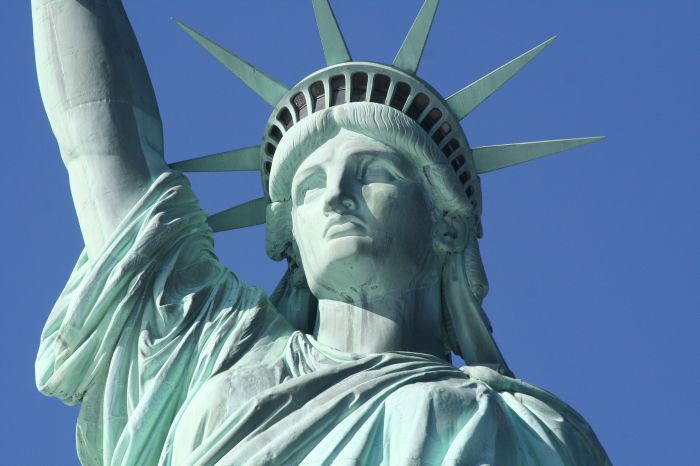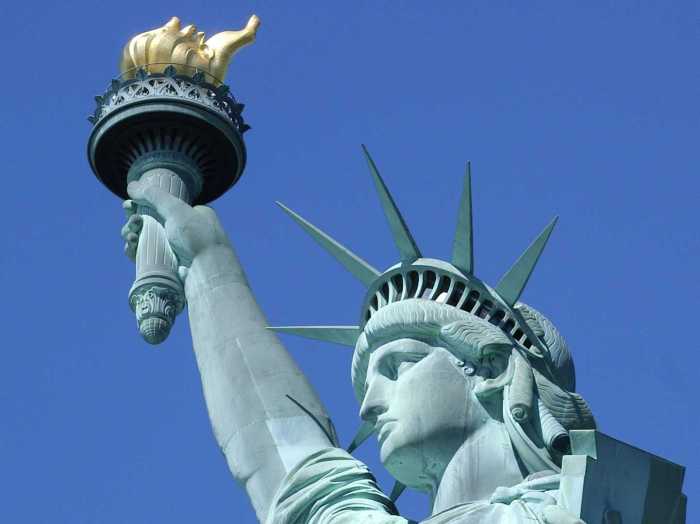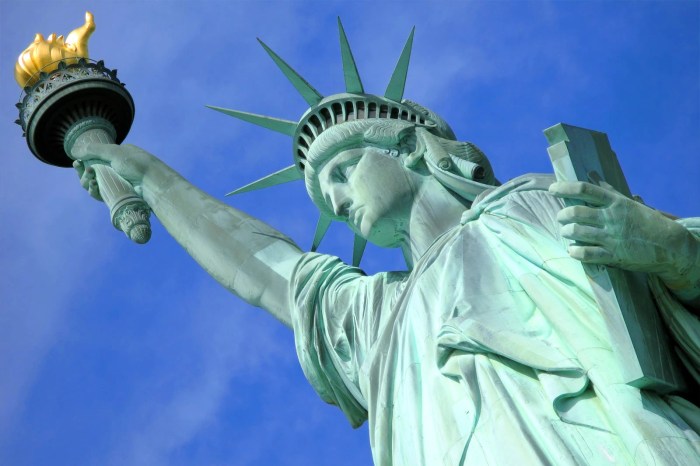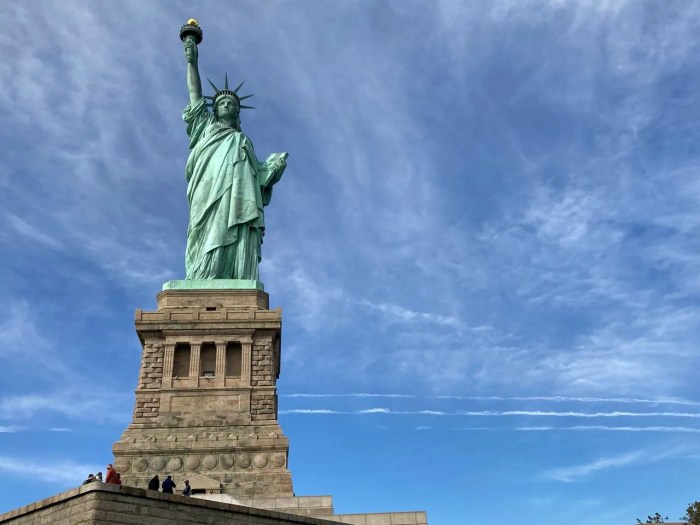The Statue of Liberty, a colossal symbol of freedom and democracy, stands tall as a beacon of hope and inspiration worldwide. Its iconic figure, standing proudly on Liberty Island, has become an enduring emblem of the American spirit, embodying the nation’s ideals and values.
From its inception to its construction and subsequent cultural impact, the Statue of Liberty has played a pivotal role in shaping American identity and fostering a sense of unity. Its enduring legacy continues to inspire generations, serving as a testament to the power of liberty and the pursuit of a better world.
Symbolism and Meaning
The Statue of Liberty stands as a towering beacon of freedom and democracy, embodying the ideals that have shaped the United States since its inception. Its iconic form has become synonymous with the pursuit of liberty, equality, and opportunity for all.
The statue’s design was meticulously crafted to convey these principles. Its torch represents enlightenment and knowledge, illuminating the path towards freedom. The broken chains at its feet symbolize the rejection of tyranny and oppression. The tablet held in its left hand bears the date of the Declaration of Independence, July 4, 1776, a testament to the founding principles of the nation.
Promoting American Values and Ideals
The Statue of Liberty has played a pivotal role in promoting American values and ideals both domestically and internationally. It has served as a symbol of hope and inspiration for immigrants seeking a better life, reminding them of the promise of freedom and opportunity.
The statue has also been a source of inspiration for social and political movements worldwide. Its image has been used to rally support for causes such as civil rights, democracy, and human rights.
Symbol of Hope and Inspiration
The Statue of Liberty has become a symbol of hope and inspiration for people around the globe. Its presence has provided comfort and encouragement to those facing adversity, reminding them that freedom and democracy are achievable ideals.
The Statue of Liberty is a symbol of freedom and democracy, standing tall and proud in New York Harbor. Just as the statue represents hope and opportunity, the Jimbaran seafood scene is a testament to the vibrant and diverse culinary experiences that await you in Indonesia.
As you explore the city, be sure to take some time to savor the delicious flavors of Jimbaran seafood, and let the spirit of the Statue of Liberty inspire your culinary adventures.
From its unveiling in 1886 to the present day, the Statue of Liberty has remained an enduring symbol of the human spirit’s unyielding pursuit of liberty and justice.
History and Design

The Statue of Liberty is a symbol of freedom and democracy around the world. But how did this iconic statue come to be? Let’s dive into its fascinating history and design.
The idea for the Statue of Liberty was conceived in the late 1860s by French sculptor Frédéric Auguste Bartholdi. He envisioned a colossal statue that would stand at the entrance to New York Harbor, welcoming immigrants and symbolizing the ideals of liberty and opportunity.
Collaboration
Bartholdi enlisted the help of renowned engineer Gustave Eiffel, who designed the statue’s internal framework. Eiffel’s innovative use of wrought iron allowed the statue to be both lightweight and incredibly strong, enabling it to withstand the harsh Atlantic winds.
Construction
The statue was constructed in France over a period of 10 years. The copper skin was hammered into shape and then assembled on the Eiffel Tower before being shipped to New York in 1885.
Architectural Design, Statue of liberty
The Statue of Liberty is an architectural marvel. Its neoclassical design features a robed female figure holding a torch in her right hand and a tablet in her left, inscribed with the date of the American Declaration of Independence (July 4, 1776).
The statue stands on a pedestal designed by American architect Richard Morris Hunt. The pedestal is made of granite and concrete and features intricate carvings depicting scenes from American history.
The Statue of Liberty, a symbol of freedom and democracy, stands tall and proud. If you’re looking for a unique shopping experience after marveling at this iconic landmark, head to the nearby Pacific Place Mall. With its upscale stores and trendy restaurants, it offers a perfect blend of luxury and convenience.
Afterwards, return to the Statue of Liberty for a breathtaking sunset view, where the copper-clad figure glows against the golden sky.
Construction and Assembly
The construction of the Statue of Liberty was a remarkable engineering feat that spanned over a decade and involved the collaboration of renowned artisans and engineers.
The statue’s frame was constructed using wrought iron, a durable material that provided both strength and flexibility. The iron framework was then covered with copper sheets, which were hammered into place to create the statue’s iconic exterior.
Techniques and Materials
- Wrought Iron:The primary material used for the statue’s framework, providing both strength and flexibility.
- Copper Sheets:Used to cover the iron framework, creating the statue’s exterior and giving it its distinctive copper color.
- Riveting:Copper sheets were secured to the iron framework using thousands of copper rivets, ensuring structural integrity.
Challenges and Triumphs
- Engineering Complexity:The sheer size and complexity of the statue presented significant engineering challenges, requiring innovative solutions.
- Material Durability:The statue’s exposed location in New York Harbor demanded materials that could withstand harsh weather conditions and corrosion.
- Labor Intensity:The construction process involved a vast workforce of skilled artisans and engineers, requiring meticulous attention to detail.
- Time Constraints:The statue was completed in time for the 100th anniversary of American independence, despite the ambitious construction schedule.
Location and Setting
Liberty Island, a small island in the heart of New York Harbor, was specifically chosen as the location for the Statue of Liberty due to its symbolic and strategic significance. The island, originally known as Bedloe’s Island, had been used for various military purposes throughout history, adding to its historical relevance.
The island’s location at the entrance to the harbor made it a highly visible and impactful sight for ships arriving in New York City. The surrounding waters and skyline provide a picturesque backdrop for the statue, enhancing its grandeur and symbolic power.
Historical and Cultural Anecdotes
- In 1877, the island was renamed Liberty Island in honor of the statue’s arrival and dedication.
- The island was originally intended to be a fort, but plans changed when it was selected as the site for the Statue of Liberty.
- The statue’s pedestal was built using granite from nearby Bedloe’s Island, further connecting it to its surroundings.
- The island has been a popular tourist destination since the statue’s dedication in 1886, attracting millions of visitors annually.
Cultural Impact and Legacy

The Statue of Liberty has become an iconic symbol of the United States and its ideals, inspiring countless works of art, literature, and popular culture.
It has played a pivotal role in shaping the national identity and fostering a sense of unity among Americans, embodying the values of freedom, democracy, and opportunity.
Influence on Art and Literature
- The statue’s majestic form and symbolism have inspired numerous paintings, sculptures, and architectural works.
- Poets such as Emma Lazarus and Walt Whitman have celebrated its significance in their verses, immortalizing its message of hope and aspiration.
- In literature, the Statue of Liberty has served as a literary device, representing themes of immigration, freedom, and the pursuit of the American Dream.
Symbol of Unity and Identity
- The statue has become a rallying point for immigrants and refugees, symbolizing the promise of a new beginning in America.
- It has been featured on postage stamps, coins, and other national symbols, reinforcing its place in the American consciousness.
- During times of crisis, such as the September 11th attacks, the Statue of Liberty has served as a beacon of resilience and hope for the nation.
Tourism and Accessibility

The Statue of Liberty is one of the most iconic landmarks in the world, attracting millions of visitors each year. Liberty Island, where the statue stands, is accessible by ferry from both New York City and New Jersey.
There are a variety of ways to visit the Statue of Liberty, including guided tours, self-guided tours, and educational programs. Guided tours are led by National Park Service rangers and provide an in-depth look at the statue’s history, symbolism, and construction.
Ticket Prices and Availability
Tickets to visit the Statue of Liberty can be purchased online or at the ferry terminals. Prices vary depending on the type of ticket and the time of year. During peak season, it is recommended to purchase tickets in advance to avoid long lines.
Guided Tours
Guided tours of the Statue of Liberty are available in a variety of languages. Tours typically last for 30-45 minutes and cover the statue’s history, symbolism, and construction. Guided tours are included in the price of admission to the statue.
Educational Programs
The National Park Service offers a variety of educational programs at the Statue of Liberty. These programs are designed to teach visitors about the statue’s history, symbolism, and impact on American culture. Educational programs are typically free of charge.
The Statue of Liberty, an iconic symbol of freedom and democracy, stands tall on Liberty Island in New York Harbor. For those seeking a vibrant beach destination after exploring this historical landmark, the bustling coastal city of Pattaya in Thailand offers a perfect escape.
With its pristine beaches, vibrant nightlife, and rich cultural heritage, Pattaya provides a delightful contrast to the Statue of Liberty’s grandeur, allowing travelers to experience both the historical significance and the vibrant energy of international destinations.
Preservation and Maintenance

Preserving and maintaining the Statue of Liberty is a continuous endeavor, requiring meticulous care and attention to detail. The statue faces various environmental challenges, including corrosion from salt air, wind erosion, and exposure to extreme weather conditions. Vandalism and graffiti also pose threats to its integrity.
To protect the statue, a comprehensive preservation plan is in place. Regular cleaning and inspections are conducted to monitor its condition and identify any potential issues. Advanced techniques, such as laser cleaning and specialized coatings, are employed to remove dirt, grime, and graffiti without damaging the delicate copper surface.
Restoration Projects
Over the years, several major restoration projects have been undertaken to address specific issues and preserve the statue’s longevity. In 1986, a comprehensive restoration was completed, which involved dismantling the statue, replacing its interior framework, and installing a new torch with a gold leaf exterior.
In 2012, Hurricane Sandy caused significant damage to Liberty Island, prompting another round of repairs and upgrades to enhance the island’s resilience to future storms.
Last Point: Statue Of Liberty

The Statue of Liberty remains an enduring symbol of the American dream, a testament to the nation’s commitment to freedom, equality, and opportunity. Its iconic presence continues to captivate and inspire, reminding us of the enduring power of human aspiration and the importance of striving for a world where liberty prevails.
FAQ Guide
What is the height of the Statue of Liberty?
The Statue of Liberty stands 305 feet 1 inch (93 meters) tall from the base of the pedestal to the torch.
Who designed the Statue of Liberty?
The Statue of Liberty was designed by French sculptor Frédéric Auguste Bartholdi.
When was the Statue of Liberty dedicated?
The Statue of Liberty was dedicated on October 28, 1886.
How many people visit the Statue of Liberty each year?
Approximately 4.5 million people visit the Statue of Liberty each year.
What is the Statue of Liberty made of?
The Statue of Liberty is made of copper sheets that were hammered into shape and then assembled over an iron framework.